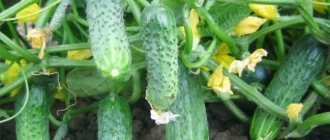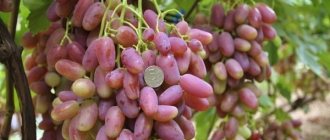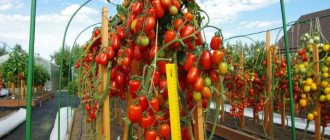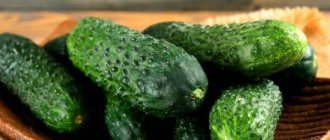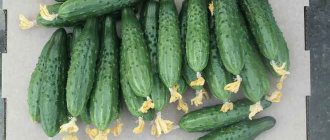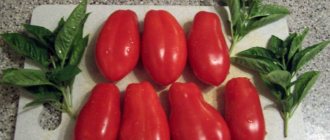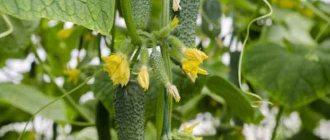The Rodnichok cucumber is a hybrid that has been popular among domestic and foreign summer residents for several decades. The appearance of the variety and its characteristics make the cucumber stand out among other hybrids of this vegetable crop.
Cucumber seeds of the Rodnichok variety
Cucumbers Fontana on a branch
An unpretentious bee-pollinated hybrid. Its fruits are sweet and not bitter
The Rodnichok variety has an excellent presentation
History of variety selection
An application for inclusion of the variety in the state register of domestic breeding achievements was submitted by scientist A.A. Mashkov. in 1974, but it was introduced only 5 years later. Place of creation: Tiraspol, Transnistrian Research Institute of Agriculture. The variety is a hybrid resistant to powdery mildew and many other diseases.
The hybrid can be grown on any soil. At first, the breeder could not get rid of the characteristic bitterness in the hybrid, but over time it completely disappeared. It can be grown in all regions of the Russian Federation.
Application
Rodnichok cucumbers are most often grown for sale. Zelentsy have exceptional product characteristics:
- Presentable appearance.
- Excellent taste.
- They do not wither or turn yellow for a long time.
- They tolerate transportation well.
- No bitterness in taste.
The positive quality of this variety is its versatility. Cucumbers are used both fresh for preparing salads and for canning. Fruits can be pickled, salted, fermented.
Description of the variety
Hybrid Rodnichok is a mid-early variety, pollination occurs with the help of bees. The plant is very tall with spreading branches, almost all the flowers are female. The harvest can be harvested 50-55 days after the first leaves appear, but the main advantage of the variety is wave-like fruiting, that is, the fruits can not be harvested immediately, but gradually, first some ripen, then others.
Fruit
Cucumbers Rodnichok have a characteristic light green hue. The weight of one is approximately 100 g, length is from 9 to 12 cm. There are stripes on the peel, and small black spikes are located across the entire surface. When cut, cucumbers give off an excellent smell and taste crisp without voids or bitterness.
Productivity and fruiting
The Rodnichok hybrid is characterized by bunch formation of ovaries, several per node, but it happens that about 5 shoots appear on 1 plant. When grown in greenhouses, you can from 1 sq. m to collect about 18-26 kg of cucumbers. In open soil, these indicators are much worse - approximately 6-8 kg.
In addition to high yields, the variety has an excellent presentation, which makes it suitable for commercial large-scale cultivation.
Application area
Cucumbers of the Rodnichok variety are not very cheap, so many people eat them fresh. Also, the reason for non-canned use is the possibility of long-term storage of the crop. But many housewives used the variety to prepare winter platters and salted the fruits.
Features and differences from other varieties
The Rodnichok variety is exactly the same as other hybrids of this crop. But there is one nuance that slightly distinguishes it from others - perfectly similar fruits of the same size. It is possible to remove cucumbers of identical length from one plant. This feature makes the hybrid the best variety of this crop for growing for sale.
If you want to grow a variety for commercial purposes, then plant it in a greenhouse. In this case, the plants will produce a better harvest and acquire the marketable appearance you need.
Resistance to diseases and pests
The variety is not afraid of downy mildew. In breeding, it is used to create other varieties and hybrids, because it is an excellent donor with innate genetic immunity to a number of infections that harm this vegetable crop.
In open ground, the plant can be attacked by aphids, so regularly treat the beds with a solution of soap, ash or other pest repellents. If insects are infested in the greenhouse, then in this case it is not the Rodnichok’s fault, but its owners.
Reviews of the cucumber variety Rodnichok F1
Gardeners' opinions about Rodnichok F1 cucumbers are presented below.
- Yana Komarova: “I love Rodnichok cucumbers very much. This is the most affordable and unpretentious hybrid, which is why I chose it. At the same time, it produces a lot of harvest. There are enough cucumbers for food and for winter preparations. They are tasty, aromatic, small in size, just the way I like them. They perform well in salting. So I recommend it."
- Inna Kolos: “I grow these cucumbers only for food. They are incredibly tasty and just what you need for summer salads. My daughters love them very much and happily eat them. I use all the extra harvest that doesn’t have time to be eaten for canning. I grow this hybrid in a film greenhouse on a trellis. Rodnichok cucumbers grow well, quickly, a lot of flowers are formed, the main thing is just to tinker a little with pollination (the variety needs pollination) and there will be a lot of harvest.”
- Leonid Baranov: “I grow F1 fontanelle every year. There are approximately 3 ovaries per node, and since the vines are long, a lot of harvest is collected from one bush. Cucumbers grow evenly, do not deform, the taste is rich, bright with a pronounced aroma. I heard that they can hurt, but I have never had such an experience. I think the main thing is to observe crop rotation and care for the bushes (preventative treatment against pests, diseases, weeding, timely watering), then there will be no problems.”
Advantages and disadvantages
This hybrid, like other vegetable crops, has pros and cons; they must be taken into account when growing.
Benefits of cucumber Rodnichok:
- excellent taste;
- beautiful appearance;
- ease of cultivation;
- strong immunity;
- the ability to grow in any area and in any conditions;
- good yield;
- excellent transportation.
Disadvantages of cucumber Rodnichok:
- demanding when it comes to fertilizing;
- needs regular and high-quality watering;
- Without proper storage of the crop, the fruits lose their attractive appearance.
The above disadvantages of the variety apply not only to Rodnichka, they apply to any vegetable crops. This variety has no specific individual disadvantages.
Further care for the Rodnichok cucumber
Further care for this vegetable crop consists of regular watering, carefully loosening the soil, removing weeds, applying fertilizer and tying canes to the trellises.
When watering, it is necessary to ensure that the top layer of soil is constantly moist. Cucumber beds should not be flooded, as excessive moisture can provoke the development of powdery mildew or fungal diseases, especially when growing cucumbers in greenhouse conditions. Water for irrigation should not be cold.
Planting and growing
Sowing hybrid seeds Rodnichok involves a number of sequential measures, and everything depends on the choice of growing location: in a greenhouse or in open soil.
Seed preparation
The hybrid Rodnichok has one characteristic feature - almost all the seeds are female, so you can do without standard heating of the seed. First of all, inspect the grains and leave only the beautiful and whole ones, then place them in a weak saline solution - the bad specimens will float, and the good ones will remain at the bottom.
There is no need to soak in different growth stimulants, especially if you bought colored seeds. Otherwise, the risk of damage to the shell will be high.
See the video for germination of seeds of hybrid varieties of cucumbers:
You can also read an additional article about planting seeds for seedlings.
Growing in open ground
Carry out preparatory activities before planting cucumber seeds in the fall. Burn the old leaves and dig up the soil. Dilute a solution of water and bleach (3%) and spray it on all surfaces of wood, metal and glass.
While digging the soil, add chicken droppings or rotted cow manure. It must be rotted, otherwise it will burn future shoots. If you don’t have organic matter in this form on your site, you can use ready-made mineral mixtures purchased at the market or in a special garden store. Just choose products labeled “for cucumbers.”
It is better to sow the fontanelle seeds in rows, so it will be easier for you to care for them in the future. Leave approximately 0.7 m between rows, and 0.3 m between seedlings.
When planting grains, deepen them into the soil by about 2 cm, water them generously and cover them with agrofibre. You can use film, the main thing is that the covering material protects the plants from return frosts.
The seeds of this hybrid germinate very quickly, and you will see sprouts 3-4 days after sowing. If it is warm outside and frosts are not predicted, then the covering material is removed so that the seedlings can soak up fresh air and warmth.
Monitor the soil moisture, it should not dry out. During the season of active plant growth, add nitrogen to the soil, fertilizers with phosphorus are suitable for flowering, and during the formation of ovaries, add potassium.
Growing seedlings
Some gardeners are sure that it is easier to first grow seedlings and replant them than to sow seeds directly into the soil. But in practice this is not entirely true. When growing seedlings, it is necessary to monitor the humidity in the room, the air temperature, illuminate the crop with additional lamps and provide extensive care.
As a substrate for grains, you can use ready-made mixtures for growing vegetables; if you do not have the opportunity to purchase them, you can make the mixture yourself. The main components for creating a substrate: fertile soil, peat and humus (in equal parts).
To plant seeds, the pots are treated with special disinfectants, for example, Gamair, Fitosporin or Planriz. Select pots with a volume of approximately 50-55 mm, deepen the seeds by 1.5-2 cm.
Until the seed germination period, keep the temperature at +23... +25 degrees Celsius. Then gradually lower it. Be sure to pick the plants into separate cups with a capacity of 45x45 mm and a volume of 80 ml.
Preparing the soil and planting seedlings
Apply fertilizers to the soil directly when planting seedlings in the soil:
- in the beds, make holes about 0.4 m deep at a distance of 0.6-0.7 m from each other;
- fill them with a layer of earth mixed with humus or compost, then add fertile soil without fertilizers;
- transfer seedlings with a clod of earth onto it or place a peat pot with seedlings on top;
- Fill the hole with soil and water at a rate of 3 liters per plant.
In the future, mulch the area with peat or dried grass. It will provide protection from weeds and will also retain moisture in the ground longer.
The following video shows how to plant sprouted cucumber seeds of the Rodnichok variety into pots:
Harvesting and storage
Fruits must be picked immediately after they reach technical ripeness. This happens on the 50-55th day. The collection is carried out every two days, sorting out substandard and disease-affected greens. The optimal cleaning time is early morning or evening, after sunset. Fruits must be placed in boxes carefully to avoid mechanical damage.
After the fruits are in the container, they are sent to a cool place. A small amount of greens in a container with holes can be placed in the refrigerator. If there are a lot of fruits, the best place is a cool basement with good ventilation. The walls of the room should first be treated with fungicide or lime in order to destroy the fungus from previously stored plant products.
Features of care
Any variety of cucumbers needs to meet all growing requirements. The main ones are: planting is carried out only in well-drained nutrient soil; during care, you must remember to regularly water with warm, settled water and apply fertilizers.
In addition, important components of the rapid growth of the Rodnichok cucumber are maintaining optimal temperature in the greenhouse, shaping the bush and spraying against pests.
Watering
Any variety of cucumbers needs high-quality watering. It is carried out only with warm water; seedlings may not perceive cold moisture at all. It is impossible to pour directly under the root, otherwise it may be exposed, as a result of which the risk of infection with various bacterial diseases will increase.
There is also no need to pour a lot of water, the root system will begin to rot, and a puddle will appear around the plant. Often such phenomena can be seen on soils with poor drainage.
If the weather gets colder, reduce the amount of watering.
In the greenhouse, before buds form, add approximately 4-5 liters of water per plant. As soon as they appear, it is necessary to stop the rapid growth of leaves and “force” the seedlings to focus on the ovaries. Watering is reduced and water is added at approximately 8 liters per 1 square meter. m once every 3 days.
If the summer season is very hot, then in addition to regular watering, spray the glass in the greenhouse and sprinkle the foliage with warm water from a spray bottle.
Top dressing
Adding manure to the soil is an excellent option for feeding crops, and Rodnichok is no exception. But this type of fertilizer can only be used as a special infusion: dilute 1 liter of fresh manure in 10 liters of water and leave it to infuse for 2 weeks. Dilute the finished mixture in water in a ratio of 1:10.
Another option for fertilizing: 5 liters of water and 7 g of ammonium nitrate, 7 g of potassium sulfate, 10 g of superphosphate. Mix all the ingredients and water the bushes at the rate of 1 bucket per 12 plants.
Apply the second feeding after 2 weeks, just as the plants begin to bloom and the first ovaries form on them. At this point, add organic matter. In addition, add to 5 liters of this product:
- 3-5 g nitrophoska;
- 100 ml wood ash;
- 0.2 g boric acid;
- 0.15 g manganese sulfate.
In this option, per 1 sq. m apply 3 liters of product. If it is not possible to create such a fertilizer, then you can use mineral fertilizers, where there should be much more potassium than nitrogen.
The third feeding is carried out after another 2 weeks. Take 5 liters of water and 1.5 tbsp. l. mullein A similar fertilizer can be used as a fourth feeding, also 2 weeks after the third.
After applying fertilizers, plants need high-quality watering.
Bush formation
The fontanelle is formed only on the trellis. Pinch the main shoot when it reaches the top row, and the side branches above the third node.
Spraying
This procedure is carried out for the following purposes:
- for foliar application of fertilizers - in 1 bucket of water, dilute 1 g of orthoboric acid, 30 g of potassium nitrate, 0.1 g of zinc sulfuric acid, 60 g of superphosphate and 150 g of urea;
- to protect against diseases and harmful insects - use Topaz or Confidor;
- during watering - use the sprinkling method.
Diseases and pests
The variety has strong immunity, but some ailments still attack it.
The most dangerous diseases:
- Powdery mildew. Symptoms: small light spots form. The fences turn brown and fall off after a while. Reasons: the presence of weeds in one area and very frequent watering. Control methods: burn the leaves and the plants themselves, treat the cucumbers with hollow sulfur powder.
- Downy mildew. Symptoms: yellow-green spots with a slight coating appear. They increase in size and turn purple. Methods of control: it is easier to take preventive measures in advance than to defeat the disease later. If you see the disease in the active phase, then treat the bushes with Bordeaux mixture.
- Anthracnose. Symptoms: brown-yellow spots with a pink coating appear. Control methods: treating plants with Bordeaux mixture.
The main pests are melon aphids, ants, spider mites, whiteflies and slugs. You will have to fight them with folk remedies and chemicals. Read more about protecting cucumbers from diseases and pests here.
Advantages and disadvantages
The hybrid attracts the attention of vegetable growers with the same size of greens, suitable for universal use. The variety has other advantages, namely:
- long fruiting;
- the presence of immunity to many diseases;
- high productivity;
- presentation;
- excellent taste.
Cucumbers tolerate transportation well, withstand heat, but are stored without processing for only 1–2 weeks. It is not possible to collect seeds from Rodnichka, but they are inexpensive.
Reviews from gardeners
★★★★★
Vera, 56 years old, librarian, Taganrog. The fruits are excellent, all of the same size, although we grow the variety for ourselves, we are sure that Rodnichok would be 100% suitable for sale.
I had to build trellises, because without them the vines would fall to the ground. I recommend to anyone who wants to grow this variety of cucumbers to plant it somewhere near an apiary, the bees will pollinate the plants and the amount of harvest will pleasantly surprise you. ★★★★★
Gleb, 44 years old, operator, Moscow. I recently bought myself a dacha and decided that I would grow cucumbers.
I chose Rodnichka, and have never regretted it. The fruits turn out excellent, in a greenhouse with 1 sq. m I collect about 15 kg of cucumbers. I think this is a good indicator, so I don’t want to experiment and plant other varieties of this crop. Rodnichok captivated me with its productivity. Hide
Add your review
Compliance with all the rules of agricultural technology, regular prevention and quality care will help you grow the Rodnichok hybrid. And he, in turn, will thank you with tasty and crispy cucumbers.
0
0
Copy link

